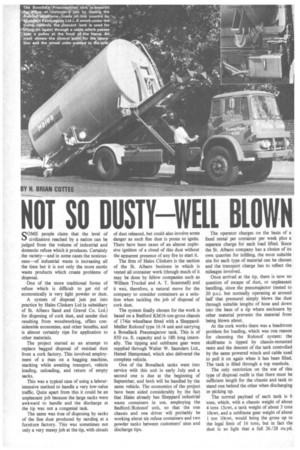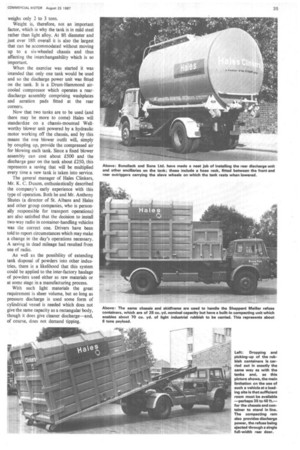NOT SO DUSTY WELL BLOWN
Page 36

Page 37

If you've noticed an error in this article please click here to report it so we can fix it.
COME people claim that the level of civilization reached by a nation can be judged from the volume of industrial and domestic refuse which it produces. Certainly the variety—and in some cases the noxiousness—of industrial waste is increasing all the time but it is not only the more exotic waste products which create problems of disposal.
One of the more traditional forms of refuse which is difficult to get rid of economically is very light powder or dust.
A system of disposal just put into practice by Hales Clinkers Ltd (a subsidiary of St. Albans Sand and Gravel Co. Ltd.) for disposing of cork dust, and sander dust resulting from woodworking, offers considerable economies, and other benefits, and is almost certainly ripe for application to other materials.
The project started as an attempt to replace bagged disposal of residual dust from a cork factory. This involved employment of a than on a bagging machine, stacking while awaiting transport, vehicle loading. unloading, and return of empty sacks.
This was a typical case of using a labourintensive method to handle a very low-value traffic. Quite apart from this it could be an unpleasant job because the large sacks were awkward to handle and the discharge at the tip was not a congenial task.
The same was true of disposing by sacks of the fine dust produced by sanding at a furniture factory. This was sometimes not only a very messy job at the tip, with clouds of dust released, but could also involve some danger as such fine dust is prone to ignite. There have been cases of an almost explosive ignition of a cloud of this dust without the apparent presence of any fire to start it.
The firm of Hales Clinkers is the section of the St. Albans business in which is vested all container work (though much of it may be done by fellow companies such as William Truckel and A. T. Scammell) and it waS, therefore, a natural move for the company to consider containers as a solution when tackling the job of disposal of cork dust.
The system finally chosen for the work is based on a Bedford KM16-ton-gross chassis of 174in wheelbase fitted with a SheppardMeiller Rolonof type 16/4 unit and carrying a Bonallack Pneumajector tank. This is of 850 Cu. ft. capacity and is 18ft long internally. The tipping and subframe gear were supplied through Walter W. Saunders Ltd., Hemel Hempstead, which also delivered the complete vehicle.
One of the Bonallack tanks went into service with this unit in early July and a second one is due at the beginning of September, and both will be handled by the same vehicle. The economics of the project have been aided considerably by the fact that Hales already has Sheppard industrial waste containers in use, employing the Bedford /Rolonof unit, so that the one chassis and one driver will probably be working about six refuse containers and two powder tanks between customers' sites and discharge tips. The operator charges on the basis of a fixed rental per container per week plus a separate charge for each load lifted. Since the St. Albans company has a choice of its own quarries for infilling, the most suitable site for each type of material can be chosen and the transport charge has to reflect the mileages involved.
Once arrived at the tip, there is now no question of escape of dust, or unpleasant handling, since the pneumajector (tested to 20 p.s.i. but normally operating at around half that pressure) simply blows the dust through suitable lengths of hose and down into the base of a tip where enclosure by other material prevents the material from being blown about.
At the cork works there was a headroom problem for loading, which was one reason for choosing the Rolonof system: the skidframe is tipped by chassis-mounted rams and the descent of the tank controlled by the same powered winch and cable used to pull it on again when it has been filled. The tank is filled through a top manhole.
The only restriction on the use of this type of disposal outfit is that there must be sufficient length for the chassis and tank to stand one behind the other when discharging or picking up.
The normal payload of each tank is 6 tons, which, with a chassis weight of about 4 tons 15cwt, a tank weight of about 3 tons lOcwt, and a subframe gear weight of about 1 ton 10ewt, would bring the gross up to the legal limit of 16 tons, but in fact the dust is so light that a full 26/28 cu.yd. weighs only 2 to 3 tons.
Weight is, therefore, not an important factor, which is why the tank is in mild steel rather than light alloy. At 8ft diameter and just over 18ft overall it is also the largest that can be accommodated without moving up to a six-wheeled chassis and thus affecting the interchangeability which is so important.
When the exercise was started it was intended that only one tank would be used and so the discharge power unit was fitted on the tank. It is a Drum-Hammond aircooled compressor which operates a reardischarge assembly comprising washplates and aeration pads fitted at the rear corners.
Now that two tanks are to be used (and there may be more to come) Hales will standardize on a chassis-mounted Wellworthy blower unit powered by a hydraulic motor working off the chassis, and by this means the one blower outfit will, simply by coupling up, provide the compressed air for blowing each tank. Since a fixed blower assembly can cost about £500 and the discharge gear on the tank about £250, this represents a saving that will be multiplied every time a new tank is taken into service.
The general manager of Hales Clinkers, Mr. K. C. Duxon, enthusiastically described the company's early experience with this type of operation. Both he and Mr. Anthony Shutes (a director of St. Albans and Hales and other group companies, who is personally responsible for transport operations) arc also satisfied that the decision to install two-way radio in container-handling vehicles was the correct one. Drivers have been told to report circumstances which may make a change in the day's operations necessary. A saving in dead mileage had resulted from use of radio.
As well as the possibility of extending tank disposal of powders into other industries, there is a likelihood that this system could be applied to the inter-factory haulage of powders used either as raw materials or at some stage in a manufacturing process.
With such light materials the great requirement is sheer volume, but so long as pressure discharge is used some form of cylindrical vessel is needed which does not give the same capacity as a rectangular body, though it does give cleaner discharge--and, of course, does not demand tipping.












































































































